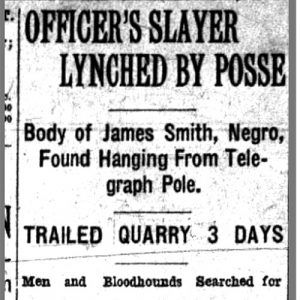calsfoundation@cals.org
James Smith (Lynching of)
James Smith, an African American man, was lynched in Crittenden County on February 8, 1917, for having allegedly killed Special Deputy Fred Hicks as Hicks attempted to arrest Smith on the charge of carrying a concealed weapon.
According to a report published in the Arkansas Gazette datelined February 5, Smith was “said to have had a bad reputation, and frequently to have caused trouble on the plantation of H. G. Long, where he was employed.” Following a night of “disorders,” apparently at the Long plantation, Hicks was deputized to arrest Smith at Proctor (Crittenden County). However, as Hicks was attempting to arrest him, Smith reportedly without warning “placed a gun against Hicks’ breast and fired,” also beating the man after he fell. Despite the mortal wound, Hicks was able to fire four shots, potentially wounding the fleeing man.
Word of the incident spread, and soon a man named Jesse Baker, said to be a “negro companion of Smith,” was arrested by Deputy Sheriff M. P. Swepson and moved to Marion (Crittenden County) out of fear that “summary vengeance will be taken against Baker, even if Smith is not caught.” (A later report, however, said that “threats had been made to use violence on [Baker] should Smith not be found.”)
Smith managed to evade capture for three days before members of a posse received word that he was hiding at a “negro shack” on Blackfish Lake, which lies to the west of Proctor. Smith was apparently warned of the posse closing in on him, and by the time the posse showed up, he had fled, leaving behind his shoes. The posse set up guard on “the approaches to the bridge across Blackfish lake” and managed to intercept Smith “shortly before daylight” as the fugitive “sneaked out of the swamps.” The posse then hanged him from the nearest telegraph pole and departed. By the time Deputy Sheriff John Tankersley arrived on the scene to arrest Smith, he found the man dead.
Although the majority of the surface area of Blackfish Lake lies in St. Francis County, the northern end of the lake lies in Crittenden County. The exact location of the lynching is not specified in reports, however.
Tankersley later stated that he believed Smith’s real name to be Coy Anderson; Anderson was wanted for the murder of a plantation manager in Mississippi the previous year. In October and November 1916, notices had appeared in the Arkansas Gazette offering $850 for the capture of Anderson, who was wanted for the murder of one Mr. Wolff near Lobdell, Mississippi, on October 12, 1916. Anderson was described as twenty-three to twenty-five years of age, five feet and eleven inches in height, and of a “dark ginger cake” complexion. On January 14, 1917, the Gazette reported that a “young negro” was being held in Newport (Jackson County) on the belief that he was Anderson, but there were no follow-up reports to indicate the confirmation of his identity; neither does there seem to have been a follow-up report confirming whether or not Smith was actually Anderson. Likewise, there seems to be no reporting on what happened to Jesse Baker.
For additional information:
“$850 Reward.” Arkansas Gazette, October 21, 1916, p. 5.
“Get Alleged Murderer.” Arkansas Gazette, November 24, 1916, p. 1.
“Hold Negro Suspect.” Arkansas Gazette, January 14, 1917, p. 12.
“Officer’s Slayer Lynched by Posse.” Arkansas Gazette, February 9, 1917, p. 1.
“Posse Hunts Negro Who Killed Deputy.” Arkansas Gazette, February 6, 1917, p. 4.
“Posse Seeks Negro Slayer of Deputy.” Arkansas Democrat, February 7, 1917, p. 2.
Staff of the CALS Encyclopedia of Arkansas
 Civil Rights and Social Change
Civil Rights and Social Change Early Twentieth Century, 1901 through 1940
Early Twentieth Century, 1901 through 1940 James Smith Lynching Article
James Smith Lynching Article 



Comments
No comments on this entry yet.